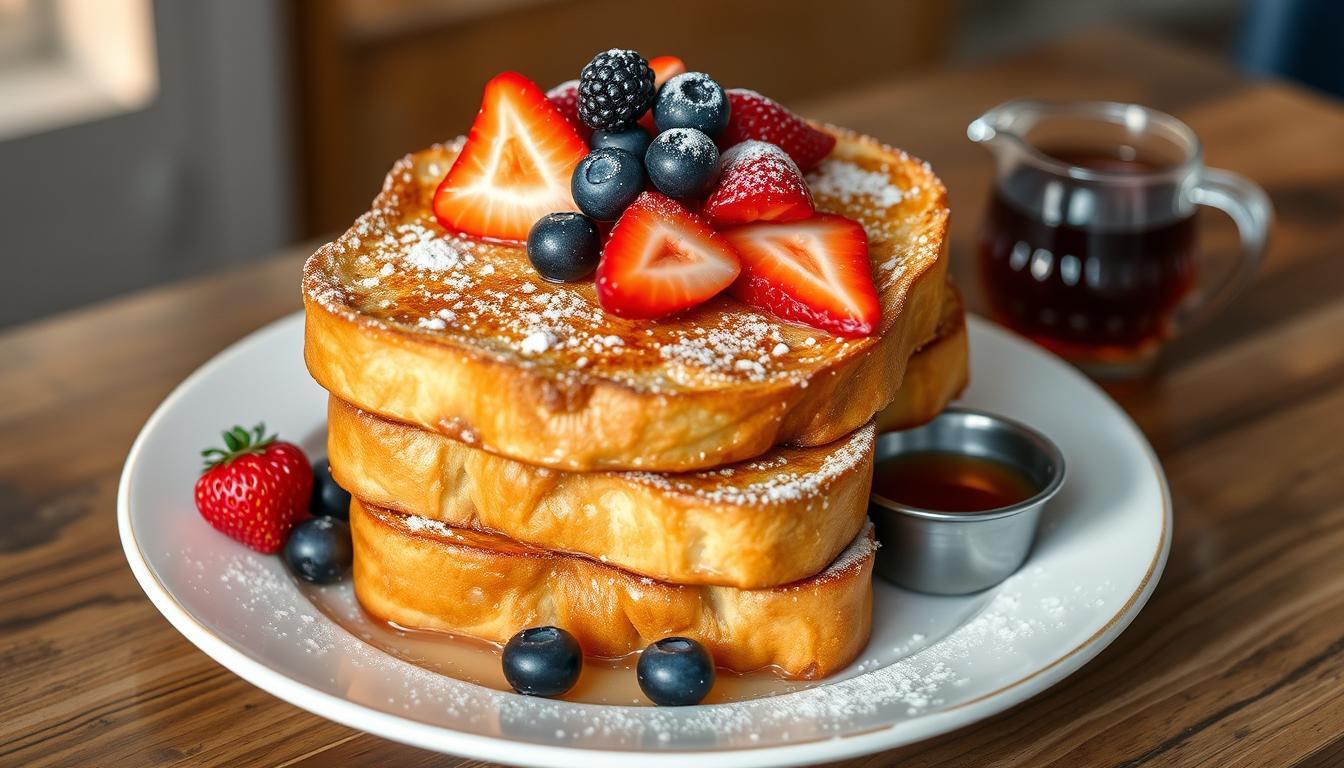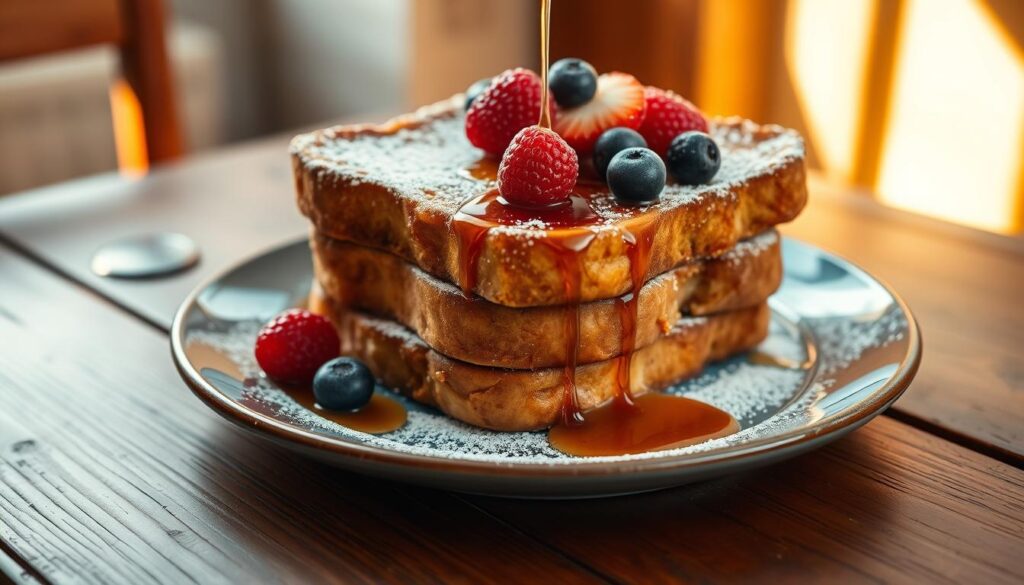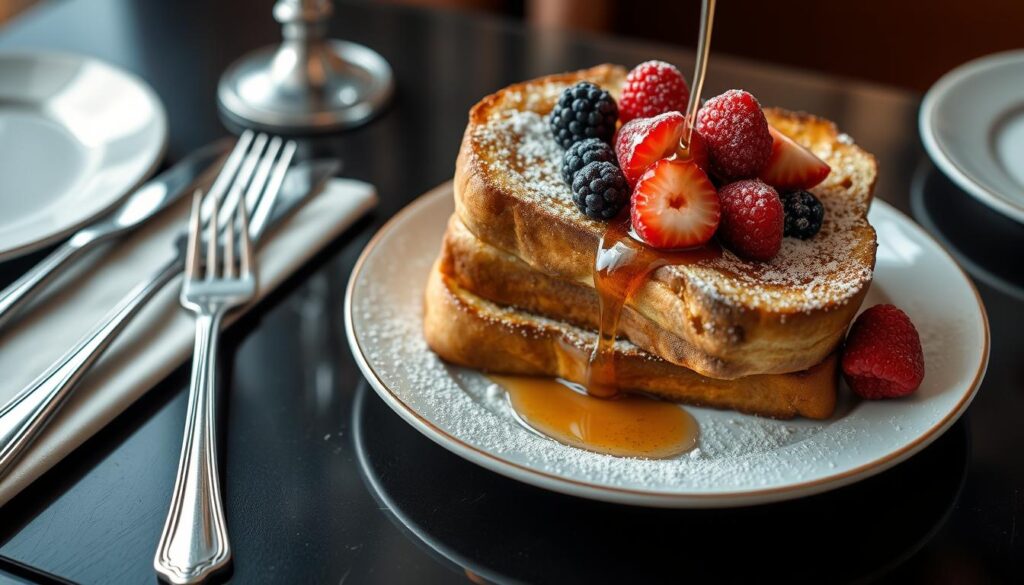
The aroma of golden-brown brioche soaked in a custard batter, infused with the warmth of vanilla and cinnamon, is a time-honored delight that has captivated brunch enthusiasts for generations. Classic French toast, with its irresistible texture and unparalleled flavors, remains a beloved favorite among breakfast and brunch connoisseurs worldwide. From its humble origins to its present-day status as a culinary icon, this versatile dish has evolved to become a cherished part of weekend indulgences, special occasion celebrations, and even romantic breakfast-in-bed moments.
Key Takeaways
- Classic French toast is a timeless breakfast and brunch favorite, featuring a golden-brown brioche base soaked in a rich custard batter.
- The dish’s enduring popularity is thanks to its irresistible flavors, which are enhanced by the addition of vanilla and cinnamon.
- French toast’s versatility makes it a perfect choice for special occasions, from weekend brunches to romantic breakfast-in-bed treats.
- The dish’s history and evolution reflect its enduring appeal as a beloved comfort food that transcends generations.
- Mastering the art of classic French toast requires attention to detail, from the quality of the bread to the perfect custard batter consistency.
The Essence of Classic French Toast
The origins of classic French toast can be traced back to ancient recipes for bread soaked in milk or eggs. This simple yet delectable dish has evolved over time, becoming a staple on brunch menus and in home kitchens around the world. But what is it about classic French toast that has made it such a beloved favorite?
Origins and Evolution
The history of French toast dates back centuries, with variations of the dish found in European cuisines as early as the 4th century. Originally known as “pan-fried bread,” this savory-sweet delicacy was a practical way to use up stale bread. Over the years, the recipe has been refined and adapted, incorporating richer ingredients like eggs, milk, and spices to create the classic French toast we know and love today.
Why It Remains a Beloved Favorite
Classic French toast has endured as a beloved breakfast and brunch staple for several reasons. Its comforting flavors, from the creamy custard-like interior to the golden-brown exterior, evoke nostalgic memories of family gatherings and special occasions. The dish’s versatility also contributes to its popularity, as it can be enjoyed in both sweet and savory variations, making it a crowd-pleasing choice for any meal.
“French toast is a timeless classic that has the power to transport us back to our childhoods and cherished moments with loved ones.”
Whether it’s a lazy weekend morning or a special celebration, classic French toast remains a beloved favorite, capturing the essence of comfort and tradition in every bite.

Classic French Toast Ingredients
At the heart of the classic French toast lies a carefully curated selection of ingredients that come together in perfect harmony. From the luxurious brioche bread that serves as the foundation to the custard batter that infuses each slice with rich flavor, every component plays a crucial role in creating this beloved breakfast delight.
Brioche Bread: A Luxurious Base
The choice of bread is paramount when it comes to classic French toast. While a variety of breads can be used, the true connoisseurs of this dish often reach for the indulgent and brioche bread. With its golden-hued crust, fluffy interior, and subtly sweet taste, brioche provides the perfect canvas for the custard batter to soak into, resulting in a truly decadent and classic French toast experience.
In addition to the brioche bread, the classic French toast ingredients typically include eggs, milk, and a selection of seasonings that lend their unique flavors to the batter. The combination of these elements creates a custard-like mixture that infuses each slice with a rich, custardy texture and a harmonious balance of flavors.
By carefully selecting and combining these classic French toast ingredients, home cooks and professional chefs alike can craft a dish that not only tantalizes the taste buds but also evokes feelings of nostalgia and comfort. Whether served as a weekend indulgence or a special occasion treat, the classic French toast remains a beloved breakfast staple that never fails to impress.
Mastering the Custard Batter
The custard batter is the heart and soul of classic French toast, providing the signature richness and creamy texture that delights the senses. Achieving the perfect consistency is crucial, as it directly impacts the overall experience. By striking the right balance between the egg-to-milk ratio and incorporating the ideal amount of vanilla and cinnamon, you can elevate the custard batter for French toast and create a truly memorable dish.
Achieving the Perfect Consistency
The key to nailing the perfect French toast texture lies in the custard batter. The ratio of eggs to milk is crucial, as it determines the thickness and creaminess of the mixture. A well-crafted custard should be thick enough to coat the bread evenly, yet still maintain a smooth, pourable consistency. Experimenting with different proportions and adjusting until you find the sweet spot is the secret to mastering this step.
Flavor Enhancers: Vanilla and Cinnamon
The addition of vanilla and cinnamon to the custard batter is a game-changer, infusing the classic French toast with a depth of flavor that complements the brioche bread beautifully. The warm, aromatic notes of these spices and extracts add a comforting touch, elevating the overall experience and creating a truly indulgent breakfast or brunch treat.

| Ingredient | Quantity |
|---|---|
| Eggs | 3 |
| Milk | 1 cup |
| Vanilla extract | 1 teaspoon |
| Ground cinnamon | 1/2 teaspoon |
| Pinch of salt | 1 |
“The custard batter is the foundation for a truly exceptional French toast. By mastering the right consistency and flavor profile, you can elevate this classic dish to new heights.”
Cooking Techniques for Perfect French Toast
Achieving the perfect classic French toast requires mastering a few key cooking techniques. The secret to getting that coveted golden-brown exterior with a soft, custard-like interior lies in the temperature of your cooking surface and the way you handle the bread.
To start, it’s crucial to heat your skillet or griddle to the right temperature – not too hot, not too cool. The optimal range is between 350°F to 375°F. This ensures the exterior cooks evenly without burning while allowing the interior to fully cook through.
- Allow the bread slices to soak in the custard batter for 2-3 minutes before cooking. This helps the bread fully absorb the eggy mixture, resulting in a rich, custardy interior.
- Use a gentle hand when flipping the French toast. Avoid pressing down too hard, as this can compromise the delicate texture. Flip the toast with a spatula, being careful not to tear the surface.
- For the perfect golden-brown color, resist the urge to overcrowd the cooking surface. Cook the French toast in batches, allowing enough space between the slices for even browning.
By mastering these simple yet essential cooking techniques for French toast, you’ll be well on your way to creating the ultimate golden-brown breakfast or brunch classic.

“The key to cooking French toast to perfection is patience and attention to detail. With the right techniques, you can achieve that irresistible crispy exterior and custardy interior every time.”
Classic French Toast
Indulge in the timeless delight of classic French toast. This beloved breakfast dish showcases the perfect balance of custard-soaked brioche bread, golden-brown exteriors, and a rich, custardy interior. Follow this classic French toast recipe to recreate the traditional flavors and textures that have made this breakfast staple a cherished favorite for generations.
Mastering the Classic Recipe
To make the classic French toast, you’ll need just a few essential traditional French toast ingredients:
- Brioche bread, sliced thick
- Eggs
- Whole milk
- Vanilla extract
- Ground cinnamon
- A pinch of salt
The key to how to make French toast at home is in the custard batter. Whisk together the eggs, milk, vanilla, cinnamon, and salt until well combined. Dip the brioche slices into the batter, allowing them to soak up the flavors and achieve that signature custardy texture.

Cook the battered bread slices on a lightly greased griddle or nonstick pan over medium heat, flipping once, until golden brown on both sides. Serve the classic French toast warm, with your choice of toppings and accompaniments for a truly indulgent breakfast experience.
Serving and Presenting French Toast
The beauty of serving classic French toast lies in the endless possibilities for creative presentation and mouthwatering toppings. Elevating this beloved breakfast staple into a visually appealing and flavorful experience is the key to delighting your guests.
Toppings and Accompaniments
When it comes to toppings for French toast, the options are truly limitless. For a decadent touch, drizzle warm maple syrup over the golden slices, allowing it to cascade down the sides. Sprinkle a dusting of powdered sugar for a classic finishing touch, or top with a dollop of whipped cream for an extra indulgent experience.
Fresh accompaniments for French toast can also elevate the dish. Consider arranging sliced fresh berries, such as strawberries, blueberries, or raspberries, around the plate for a vibrant pop of color and flavor. For a savory twist, crispy bacon or sausage links can provide a delightful contrast to the sweet custard-dipped bread.

When it comes to French toast presentation, the possibilities are endless. Arrange the slices in a fan or stack them high, drizzling the toppings over the top for a visually stunning display. Garnish with fresh herbs, such as mint or thyme, for a touch of elegance. Serve the French toast with a side of warm syrup or fruit compote, allowing your guests to customize their experience to their liking.
By paying attention to the serving and presenting of French toast, you can transform a simple breakfast dish into a true culinary masterpiece, captivating the senses and creating a memorable dining experience.
French Toast for Special Occasions
Classic French toast is not just a delightful breakfast option; it can also be the centerpiece of special occasions. From leisurely weekend brunches to romantic breakfast-in-bed surprises, this indulgent dish elevates any gathering and creates memories that last.
Weekend Brunch Indulgence
French toast for brunch is a beloved tradition, allowing families and friends to savor the comforting flavors and textures of this classic dish in a relaxed and convivial setting. The aroma of cinnamon-dusted brioche bread soaked in a rich custard batter wafting through the air sets the tone for a leisurely weekend morning, inviting everyone to slow down, connect, and indulge.
Breakfast in Bed: A Romantic Treat
For a truly special occasion, such as Mother’s Day or an anniversary, French toast for breakfast in bed is a thoughtful and indulgent gesture. The combination of fluffy, golden-brown French toast, fresh fruit, and a drizzle of maple syrup creates a visually stunning and mouthwatering presentation, making it the perfect way to surprise a loved one and start the day on a delightful note.
Whether served at a leisurely brunch or as a romantic breakfast-in-bed treat, classic French toast has the power to transform ordinary moments into extraordinary celebrations, creating cherished memories and bringing people together around the table.
Variations on the Classic
While the classic French toast recipe is a beloved staple, the versatility of this dish allows for endless creative possibilities. Chefs and home cooks alike have explored a wide range of sweet and savory French toast variations to delight the senses and satisfy diverse palates.
Sweet Twists on French Toast
For those with a sweet tooth, the options for French toast innovations are truly tantalizing. Recipes featuring sweet French toast can incorporate a variety of indulgent ingredients, such as:
- Brioche bread infused with vanilla bean or citrus zest
- A custard batter enriched with maple syrup or honey
- Toppings like fresh berries, caramelized bananas, or whipped cream
Savory French Toast Creations
While French toast is often associated with breakfast and brunch, the dish can also be transformed into a savory delight. Savory French toast recipes may feature:
- Hearty breads like sourdough or pumpernickel
- A custard batter seasoned with herbs, spices, or even cheese
- Unconventional toppings such as roasted vegetables, fried eggs, or crumbled bacon
These French toast variations showcase the dish’s adaptability, allowing it to be enjoyed as a sweet indulgence or a savory delight, depending on individual preferences and culinary creativity.
French Toast in Restaurants and Cafes
The enduring popularity of classic French toast is evident in its ubiquitous presence on menus across the United States. From upscale restaurants to charming neighborhood cafes, chefs and restaurateurs have elevated this beloved breakfast staple, showcasing their culinary creativity and expertise.
At renowned establishments, French toast is often a standout item on brunch menus, attracting diners in search of a gourmet interpretation of the classic. Artisanal bakeries may offer their own signature version, using housemade brioche or sourdough bread as the foundation for a rich, custard-like batter. Innovative chefs have experimented with unique flavor profiles, such as incorporating aromatic spices, decadent syrups, or even savory elements like smoked salmon or prosciutto.
The visual appeal of French toast has also become a point of emphasis in the culinary world. Restaurants and cafes often present the dish in an aesthetically pleasing manner, garnishing it with seasonal fruits, powdered sugar, or artful drizzles of maple syrup. This attention to presentation not only enhances the dining experience but also contributes to the cultural significance of French toast as a cherished menu item that evokes a sense of nostalgia and indulgence.
FAQ
What is the key ingredient that makes classic French toast so delicious?
The use of brioche bread is essential for classic French toast. Brioche’s rich, buttery texture and subtle sweetness provide the perfect base for the custard batter, allowing the flavors to meld together seamlessly.
How do I achieve the perfect custard batter for my French toast?
The key to a perfect custard batter lies in balancing the egg-to-milk ratio and incorporating the right amount of vanilla and cinnamon to enhance the flavors. Achieving the right consistency is crucial for ensuring a rich, creamy texture to your French toast.
What are some tips for cooking classic French toast to perfection?
To cook classic French toast to perfection, it’s important to use the right temperature for the cooking surface, allow the bread to soak in the custard batter, and follow techniques that ensure a golden-brown exterior with a soft, custard-like interior.
What are some popular toppings and accompaniments for classic French toast?
Classic French toast pairs beautifully with a variety of toppings and accompaniments, such as maple syrup, powdered sugar, fresh fruit, whipped cream, and even savory additions like bacon or sausage. The right garnishes and presentation can elevate the dish to make it a true centerpiece for a special brunch or breakfast.
How can I enjoy classic French toast for special occasions?
Classic French toast is a versatile dish that can be enjoyed for a variety of special occasions, from leisurely weekend brunches with family and friends to romantic breakfast-in-bed treats. Its comforting and indulgent nature makes it the perfect choice for elevating these memorable moments.
Are there any unique variations on the classic French toast recipe?
Yes, the classic French toast recipe can be creatively adapted and reimagined with both sweet and savory twists. From using different types of bread to infusing the custard batter with unique flavors or incorporating unexpected toppings and fillings, the possibilities for French toast variations are endless.
How is classic French toast celebrated in the culinary world?
Classic French toast continues to be a beloved menu item in restaurants and cafes across the United States. Chefs and restaurateurs have elevated the dish with gourmet ingredients, unique flavor profiles, and visually stunning presentations, cementing its status as a timeless classic that delights diners.

Leave a Reply